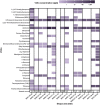What a mix! Volatile organic compounds and worker exposure in small business beauty salons in Tucson, Arizona
- PMID: 38164445
- PMCID: PMC10757921
- DOI: 10.3389/fpubh.2023.1300291
What a mix! Volatile organic compounds and worker exposure in small business beauty salons in Tucson, Arizona
Abstract
Introduction: Small business beauty salons have volatile organic compounds (VOCs) in their workplace air. VOCs are present as ingredients in beauty or hair products. They may also form because of chemical reactions, where thermal-styling elements accelerate the volatilization of these compounds. Uncertainties remain about the relationship between air pollutant concentrations and the variety of beauty salon activities in a work shift. Investigating these associations can help determine high-risk services, associated products, and at-risk workers.
Methods: In this exploratory study, female community health workers recruited beauty salons from target zip codes in predominately Latino neighborhoods, including primarily Spanish-speaking small businesses. We collected salon chemical inventories, business characteristics, and participant activity logs to understand how chemicals and activities influence the total and specific VOC concentrations. We sampled personal total VOCs and specific VOCs from the same shop during the participant work shift. We also measured personal total VOCs for four work shifts per shop.
Results: A linear mixed effects model of log VOCs on the fixed effect of activity and the random effects of salon and shift within the salon showed that the variance between salons explains over half (55%) of the total variance and is 4.1 times bigger than for shifts within salons. Summa canisters detected 31 specific VOCs, and hazard scores ranged between 0 and 4.3. 2-Propanol (isopropyl alcohol) was the only VOC detected in all shifts of all salons.
Discussion: In this study, differences in VOC measurements were primarily between salons. These differences may result from differences in ventilation, services rendered, and product lines applied.
Keywords: Spanish-speaking small businesses; VOC exposure; beauty justice; beauty salons; heat-styling; hierarchy of controls; salon products; worker health.
Copyright © 2023 Ramírez, Gutenkunst, Lothrop, Quijada, Chaires, Cortez, Sandoval, Camargo, Gallardo, Torabzadeh, Wagoner, Lopez-Galvez, Ingram, Billheimer, Wolf and Beamer.
Conflict of interest statement
The authors declare that the research was conducted without any commercial or financial relationships that could be construed as a potential conflict of interest.
Figures



References
-
- Fortune business insight. Market research report: Salon services market size, share & COVID-19 impact analysis, by service type, by end-user, and regional forecast, 2023–2030. India: Fortune Business Insight; (2023). 195 p.
-
- Hair Care Worldwide . Statista. New York: Statista; (2023).
-
- Peiser J. Inflation can't smudge the glowing beauty industry. Washington Post, Maryland: Sect. Business; (2023).
-
- Nelson E. Rising lipstick sales may mean a pouting economy. Wall Street Journal (New York Ed). (2001).
-
- Ilic-Godfrey S. Recovering from the pandemic: a bright outlook for the personal care service industry. Beyond numbers: Employment & Unemployment, U.S. Bureau of Labor Statistics. (2022) 11.
Publication types
MeSH terms
Substances
Grants and funding
LinkOut - more resources
Full Text Sources
Medical

